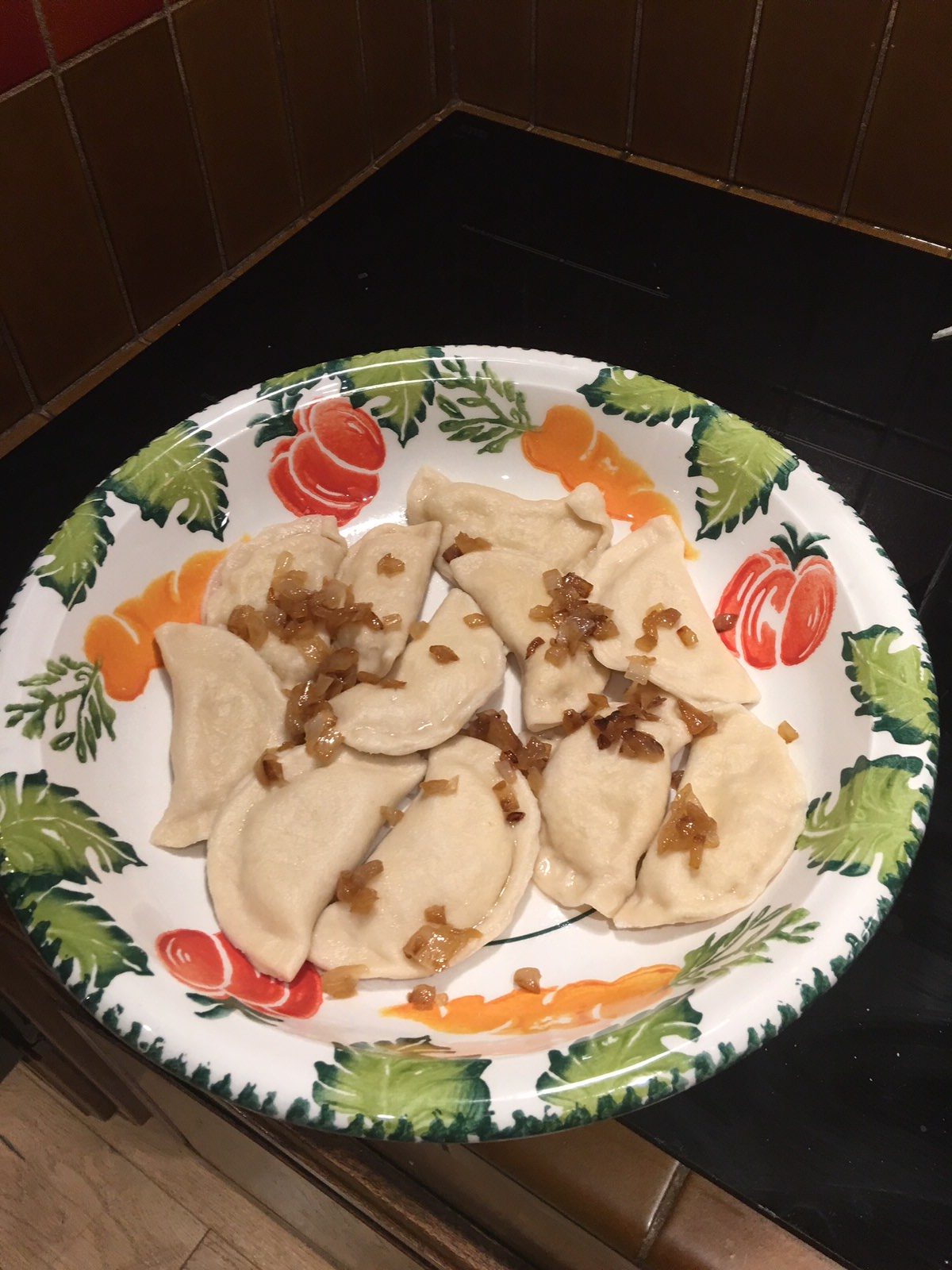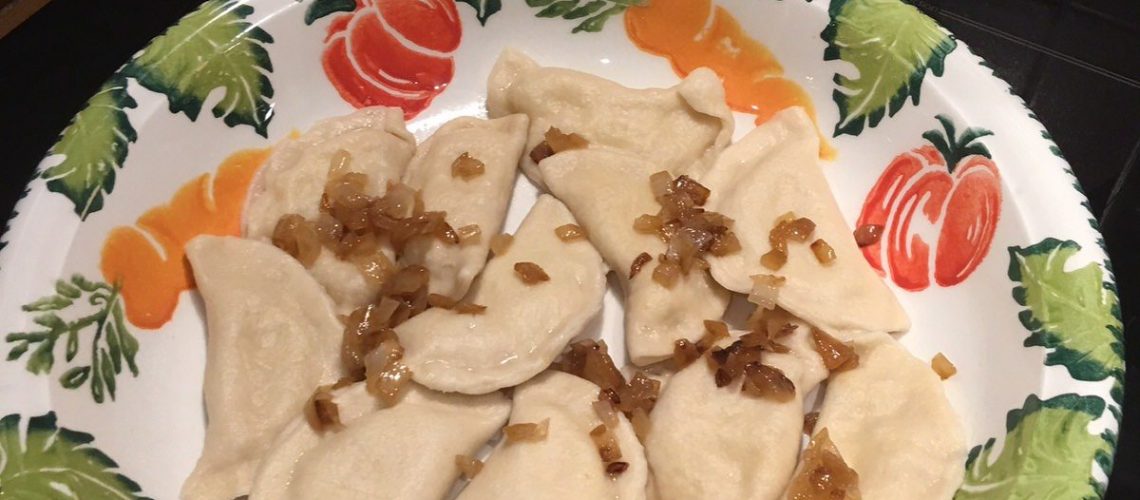The bell rang, so I dropped the potato I was peeling and ran to open the door for our dinner guests. We were having a little pre-Christmas gathering with a small group of friends who were going to learn how to make our favorite Polish “soul food,” pierogis. They’re a dumpling you can fill with all different kinds of stuffing—sweet, like fresh berries, or savory like sauerkraut with mushrooms, or even ground meat. Every culture has some version of this dish, from dim sum to ravioli to empanadas and samosas.

Our Christmas tree was decorated with the ornaments we’d collected over the years, giving off a strong smell of fir, bringing deep memories from our childhood homes in Poland. Flames were dancing in the fireplace while soft jazz flooded the house. It felt like the Christmas spirit was with us, ushering in the beginning of the holidays.
When I opened the door there was a beautiful basket of white orchids greeting me with the smiling faces of our friends behind them. There was one unexpected guest—a man with a kind face and smiling eyes wearing saffron and burgundy robes.
“Welcome to our humble home,” I said.
Everyone arranged themselves on sofas around the fireplace and we made introductions. We started with tea and holiday drinks, and then everyone got up to help me prepare the pierogis in the kitchen nearby. What I like about our dinners is that our friends usually don’t like to be “served,” preferring instead to dig in and participate in the cooking. That night we were stuffing the pierogis with Polish farmer’s cheese, potato, and sautéed onion. Our mystery guest was a monk from Bhutan, who had pulled out his iPhone to watch the Dalai Lama making a live speech. I invited him to join the cooking crew, which he did with enthusiasm. I noticed that he had beautiful, nimble, unblemished hands, and wondered how often he really cooked.
After we’d finished the preparation of the pierogis and they were boiling away in a big pot, we returned to the living room and our special guest asked me about the tradition behind our Christmas tree. We explained our Polish roots, and how we’d always harvested a tree to decorate for Christmas. He wanted to know what it symbolized, and we realized that for us it represented bounty and abundance in an otherwise poor landscape. We always looked forward to gathering the extended family together around the tree, eating well and being warm together in a nurturing environment. It brought about reconciliation and forgiveness along with joy and celebration. We asked the monk if he had a similar celebration at his home in Bhutan.

He mentioned that they celebrated Buddha’s birthday by planting a tree. It surprised him that we would cut down so many trees every year just for a few days of decoration. To him, it just didn’t make sense. Jerzy brought up the power of old traditions and how they’re ingrained in our hearts and psyches, and are very difficult to change. I explained that trees are also farmed here for the purpose of sustainable harvests, and that I’ve learned artificial trees can be harmful with their environment-damaging, toxic materials that can’t be recycled. I also mentioned that we’d had trees in the past with roots that we could bring inside in buckets and then replant outside. Now, apparently, you can even rent a live tree and return it after the holidays. As we explored the topic, we realized that we were experiencing a clash of culture and beliefs, and that to put down anyone’s cultural tradition can cause strong reactions. We defend our traditions with our hearts, not our brains. They don’t always make “sense” when viewed from outside. If we come from a position of curiosity and understanding, discussions can blossom and cultural exchange can take place without judgment or condemnation. We can learn from each other and something can shift.

DEEPER CONTEMPLATION
Do you have traditions that you follow, and have you examined them or have they shifted over time? Have you ever clashed with someone over a religious or cultural tradition? How did it resolve? Are there traditions and practices from other cultures you’ve adopted for your own life? What guided you to incorporate them into your own personal culture?
Leave your response below in the comments.



Thank you for sharing. I will be visiting Bhutan this April (organized tour with a Polish travel agency). I look forward to learning more about people living there and their culture. Of course, I will share all my impressions with you.
Katharina, how fun! Some time ago I’ve read that Bhutan was voted as the happiest place on earth. Can’t wait for you to share your experiences.
I was raised in a conservative Jewish house to eat kosher and to only date/marry someone who is also Jewish. I had my first cheeseburger, very not kosher, when I was 15 simply because all my friends were eating it and I didn’t want to keep being left out. Also no one provided scientific proof for why a cheese burger was “bad”. All I heard from fellow Jews was that mixing milk and meat was a sin. Well a sin never tasted so delicious. And I came to discover that a lot of kosher laws are based in 2,000+ year old traditions that at one time possibly had a valid health reason behind them but no longer apply.
Eventually I married a Christian and we had children. To some Jews this is one of the ultimate sins. For some murder is even better (not kidding). My older brother , who is now an Orthodox Jew, refused to attend the wedding and still refuses to acknowledge my 7 and 9 year old sons (his nephews). This pushed me further away from Judaism as a religion. I love the Jewish humor and food too much to abandon the culture – couldn’t imagine a life without Matzo ball soup , pastrami and bagels.
Recently I tried to talk to my brother about his differences and rejection and how hurtful it has been. I have also spoken to other Orthodox Jews, even the son of a Rabbi, and my brother’s belief that my children are not his family and his hateful actions unequivocally do not mirror Judaism as a whole. In fact it teaches the opposite.
I pray one day that my brother realizes the radical religious leaders he follows are false prophets and he can reconnect. Judaism will never be the same for me. The religion has been tainted in my mind by bigotry and exclusion. Why do the once oppressed upon become the oppressors?
I don’t follow any religion now except my heart. It’s the only thing that remains pure
Jay,
I must say you have had interesting and challenging experiences in life. Following your heart that has pure intention is the best spiritual path you can take – I really admire you for standing your ground and creating life that is inclusive and open to positive changes. My hope for you is that you will reconcile with your brother, making your relationship as brother and sister more important than religion. We all are capable to coexist even we don’t agree on some things.
My friends Barbara and Bill are Jewish and Catholic and I love how, despite of different religious backgrounds, they’ve created a family life that has both aspects of religions included. They’ve come to compromise somehow and practice and celebrate both.
Wow, thanks you so much for sharing. I miss my mother’s pierogis!
You welcome Greg! There is a special time to indulge a little in “soul food” like around holidays. Moderation is the key.
Jerzy & Aniela…Can you share your pierogi recipe?
Tash,
I googled “making pierogis” and as I searched for a simple recipe I found out that ours is the simplest and much less caloric because we avoid things like butter, cream cheese, milk, or eggs.
So here it is:
Filling: boiled and mashed potatoes (choose drier kind like Russet) mixed with farmer’s cheese (European style) and sauté onions (sauté more and leave some for garnish) than add salt and pepper for taste.
Dough as you would make for noodles: flour, warm water pinch of salt.
Boil water beforehand. When you are done with making pierogis, lower the heat and gently drop them in. Wait until pierogis surface to the top. Scoop them and garnish with the left over sauté onion.
If you would like to learn how to actually fill the dough with the potato/cheese mix, you can watch a video on youtube. Good luck and let me know your experience.
Smacznego!